跨文化商务交际Wk11 Intercultural Business Communication
跨文化商务交际-unit 11Barriers to Intercultural Communication
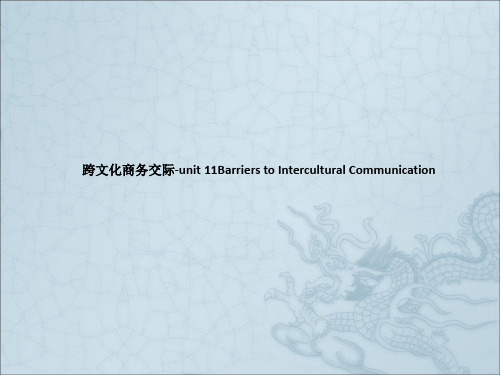
Notes
1. They include 'noise', in the technical sense of interference, whether physical or psychological, which prevents messages from being received; poor encoding by the sender; distortion by the medium; and selection, inaccurate decoding, distorted interpretation and indiscriminate categorization by the receiver.
【译文】当人们主要以团队成员的身份相互交流 时,即使只在两人之间行,“社会集团内部对 抗”以及“社会集团内部交际”这样的术语也适 用。
【注】intergroup communication 指个体之间相互交流时, 通常是他们相互之间主要的社会成员关系,而不是个体特 征左右相互的交流。因此,社会集团内部交际研究成员相 互之间的交流是怎样认同与社会中不同集团成员之间的身 份,以及集团与集团成员之间的信息是怎样进行交流的。 尽管交际被公认为既是个体之间,亦是集团之间的行为, 但是研究社会集团内部交际的学者却声称人们之间的大多 数交流从某种意义上讲,是集团内部的交际。集团包括年 龄、种族、性取向、以及政治派别等。社会集团内部交际 被视为是一个动态的过程,每一位交流者的认知、情绪、 动机都在彼此互动中对交际行为产生影响。
跨文化商务交际-unit 11Barriers to Intercultural Communication
Text 1
Pre-reading questions: 1. How does miscommunication
跨文化商务沟通 Cross-cultural Communication WK

Functions
The interfacing of the verbal with the nonverbal carries over to the many uses and functions of nonverbal behavior. Functions:
- Repeating - Complementing - Substituting - Regulating - Contradicting
2
Culture- Time Orientation
• Value to Time Monochronic vs Polychronic
Monochronic- ONE thing focused One time Using time in linear way
Polychronic- Manage many things together - Change plans easily and always
22
13
Elements- Channel/Medium
LOWEST
HIGHEST
Impersonal Static Media
(flyers, bulletins, generalised
computer reports)
Personal Static Media
(memos, letters, tailored computer Reports)
Nonverbal communication involves all those
nonverbal stimuli in a communication setting
that are generated by both the source and his or her use of the environment and that have
《跨文化商务交际》课程学习大纲课程名称:跨文化商务交际课程英文
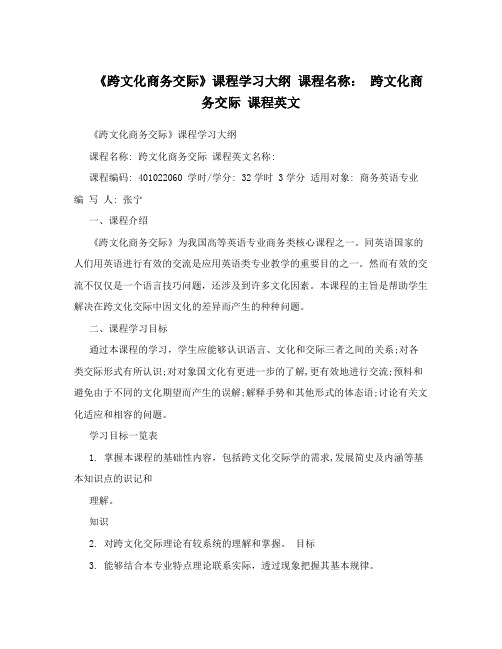
《跨文化商务交际》课程学习大纲课程名称:跨文化商务交际课程英文《跨文化商务交际》课程学习大纲课程名称: 跨文化商务交际课程英文名称:课程编码: 401022060 学时/学分: 32学时 3学分适用对象: 商务英语专业编写人: 张宁一、课程介绍《跨文化商务交际》为我国高等英语专业商务类核心课程之一。
同英语国家的人们用英语进行有效的交流是应用英语类专业教学的重要目的之一。
然而有效的交流不仅仅是一个语言技巧问题,还涉及到许多文化因素。
本课程的主旨是帮助学生解决在跨文化交际中因文化的差异而产生的种种问题。
二、课程学习目标通过本课程的学习,学生应能够认识语言、文化和交际三者之间的关系;对各类交际形式有所认识;对对象国文化有更进一步的了解,更有效地进行交流;预料和避免由于不同的文化期望而产生的误解;解释手势和其他形式的体态语;讨论有关文化适应和相容的问题。
学习目标一览表1. 掌握本课程的基础性内容,包括跨文化交际学的需求,发展简史及内涵等基本知识点的识记和理解。
知识2. 对跨文化交际理论有较系统的理解和掌握。
目标3. 能够结合本专业特点理论联系实际,透过现象把握其基本规律。
1. 通晓跨文化交流的本质、基本理论和技巧。
2. 了解文化差异产生的过程。
能力目标 3. 掌握基本的沟通方法和策略。
4. 提高英语语言运用能力和跨文化交际能力1. 培养科学、严谨的学习态度、执着探索、创新改革的科学精神。
文化素质2. 培养自身的国际视野、创新意识、跨文化交际和人际交往意识。
目标三、课程教学内容《跨文化商务交际》课程的教学内容共分为八个模块,每个模块由基础性内容、提高性内容、拓展性内容三部分构成,基础性内容是必须掌握的内容,提高性内容是在基础性内容的基础上对基本问题的探讨和梳理,拓展性内容是对所学知识的延伸性学习,是课程内容的前瞻性分析和理论延展。
第1至4章以跨文化交际学的基本理论为框架,阐述阐述交际、文化、跨文化交际等基本概念、交际与文化的关系;介绍文化差异在言语和非言语交际方面的表现;不同的文化价值观的理论划分,以及在文化层面上分析了人们在跨文化商务交际中存在的众多价值观念差异。
跨文化商务交际导论

跨文化商务交际导论跨文化商务交际导论一、概述跨文化商务交际(Cross-cultural Business Communication)是一门介于文化语言学科和商务管理学科交叉融合的新兴学科,是指在国际贸易、国际投资、国际金融、国际工程施工、国际联合研究、国际职业拓展及国际文化传播等方面,研究不同文化背景下的人在进行商务活动时的沟通交流方式。
跨文化商务交际是培养商务人员在跨文化领域内从事商务活动所必备的能力,因此也被称为“商务跨文化能力教育”。
跨文化商务交际不仅包含语言交流,还应当涵盖文化差异的认知、文化背景的熟悉以及语言交流技巧等多方面内容,在当今社会经济全球化的大背景下,跨文化商务交际技能已成为企业优秀人才的基本要求。
二、基本内容1.跨文化商务交际的基本概念:(1)概念跨文化商务交际是指企业、组织在拓展国际市场、开拓国际业务等活动中,在实施国际战略时,探索文化影响下的商业交流模式,实现交际效果的一门科学。
(2)定义跨文化商务交际是指在国际贸易、国际投资、国际金融、国际工程施工、国际联合研究、国际职业拓展及国际文化传播等方面,研究不同文化背景的人在进行商务活动时的沟通交流方式的学科。
2.跨文化商务交际的基本内容(1)文化差异文化差异是国际商务活动中,不同民族、不同团体之间具有明显不同的文化特性和价值取向的状态,是影响商务沟通的重要因素。
(2)文化背景文化背景指每一文化有其独特的文化特征,可以帮助人们理解彼此的做法和思维方式,为了有效地实施跨文化商务交际,必须有效地探索和了解不同文化的基本特点。
(3)语言交流语言交流是指双方运用不同语言在跨文化商务实践中实现有效沟通的过程,需要根据语言和文字之间的关系洞察语言的双重性、多样性以及有效表达语言信息的方式。
(4)沟通技巧沟通技巧包括言语表达技巧、语言表达技巧、文化表达技巧等,是跨文化商务活动中的重要组成部分,也是提高跨文化商务技能的关键因素。
三、结束语跨文化商务交际是一门介于文化语言学科和商务管理学科交叉融合的新兴学科,它涵盖了文化差异的认知、文化背景的熟悉以及语言交流技巧等多方面内容。
跨文化商务沟通
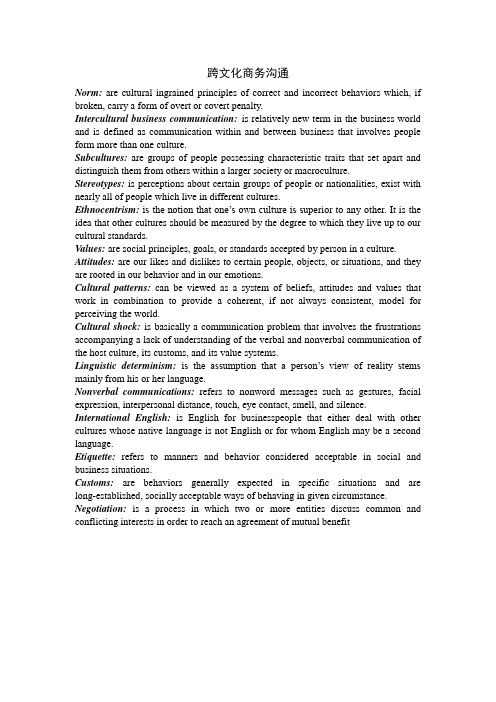
跨文化商务沟通Norm:are cultural ingrained principles of correct and incorrect behaviors which, if broken, carry a form of overt or covert penalty.Intercultural business communication:is relatively new term in the business world and is defined as communication within and between business that involves people form more than one culture.Subcultures:are groups of people possessing characteristic traits that set apart and distinguish them from others within a larger society or macroculture. Stereotypes: is perceptions about certain groups of people or nationalities, exist with nearly all of people which live in different cultures.Ethnocentrism:is the notion that one’s own culture is supe rior to any other. It is the idea that other cultures should be measured by the degree to which they live up to our cultural standards.Values: are social principles, goals, or standards accepted by person in a culture. Attitudes: are our likes and dislikes to certain people, objects, or situations, and they are rooted in our behavior and in our emotions.Cultural patterns:can be viewed as a system of beliefs, attitudes and values that work in combination to provide a coherent, if not always consistent, model for perceiving the world.Cultural shock: is basically a communication problem that involves the frustrations accompanying a lack of understanding of the verbal and nonverbal communication of the host culture, its customs, and its value systems.Linguistic determinism:is the assumption that a person’s view of reality stems mainly from his or her language.Nonverbal communications:refers to nonword messages such as gestures, facial expression, interpersonal distance, touch, eye contact, smell, and silence. International English:is English for businesspeople that either deal with other cultures whose native language is not English or for whom English may be a second language.Etiquette:refers to manners and behavior considered acceptable in social and business situations.Customs:are behaviors generally expected in specific situations and are long-established, socially acceptable ways of behaving in given circumstance. Negotiation:is a process in which two or more entities discuss common and conflicting interests in order to reach an agreement of mutual benefit。
《跨文化商务交际》课程简介
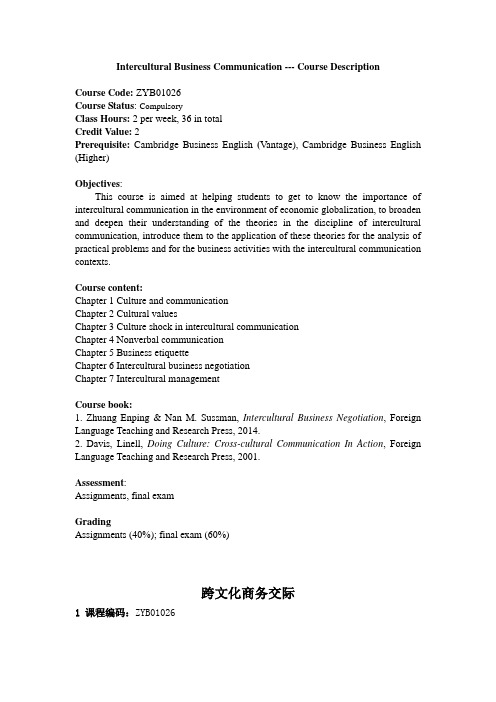
Intercultural Business Communication --- Course DescriptionCourse Code: ZYB01026Course Status: CompulsoryClass Hours: 2 per week, 36 in totalCredit Value: 2Prerequisite: Cambridge Business English(Vantage), Cambridge Business English (Higher)Objectives:This course is aimed at helping students to get to know the importance of intercultural communication in the environment of economic globalization, to broaden and deepen their understanding of the theories in the discipline of intercultural communication, introduce them to the application of these theories for the analysis of practical problems and for the business activities with the intercultural communication contexts.Course content:Chapter 1 Culture and communicationChapter 2 Cultural valuesChapter 3 Culture shock in intercultural communicationChapter 4 Nonverbal communicationChapter 5 Business etiquetteChapter 6 Intercultural business negotiationChapter 7 Intercultural managementCourse book:1. Zhuang Enping & Nan M. Sussman, Intercultural Business Negotiation, Foreign Language Teaching and Research Press, 2014.2. Davis, Linell, Doing Culture: Cross-cultural Communication In Action, Foreign Language Teaching and Research Press, 2001.Assessment:Assignments, final examGradingAssignments (40%); final exam (60%)跨文化商务交际1 课程编码:ZYB010262 课程名称:跨文化商务交际3 课程性质:专业必修课程4 教学时数:365 学分:26 先修课程:剑桥商务英语7 教学目标与内容:通过本课程的学习,学生应能够认识到经济全球化环境下跨文化商务交际的重要性,扩大和加深学生对跨文化交际学领域中相关理论的了解,引导学生运用跨文化交际学的理论对现实问题进行分析,在跨文化背景下能有效地进行各种商务活动。
跨文化商务交际Wk4 Intercultural Business Communication
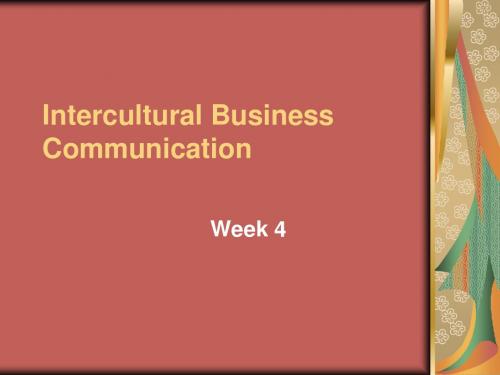
Long-term vs. Short-term
Long-term- values oriented towards the future; Short-term- values rather oriented towards the past and present
Hofstede’s Cultural Dimensions
Attitudes & Behaviors Individualists
Speak your mind and tell the truth
Collectivists
Maintain harmony and avoid confrontations
- Typical characteristics (Decentralization; Active participation, etc) - In business management world (Obedience; Execution; Saying ‘yes’)
Hofstede’s Cultural Dimensions
Hofstede’s Cultural Dimensions
Collectivism (集体主义) - common interests, conformity, cooperation & interdependence
Collectivism indicates a tight social framework in which people distinguish between in-groups & out-groups and expect their in-group to look after them
Social values
英语作文 国际商务与跨文化交际(International Business and Cross-cultural Communication)-精品
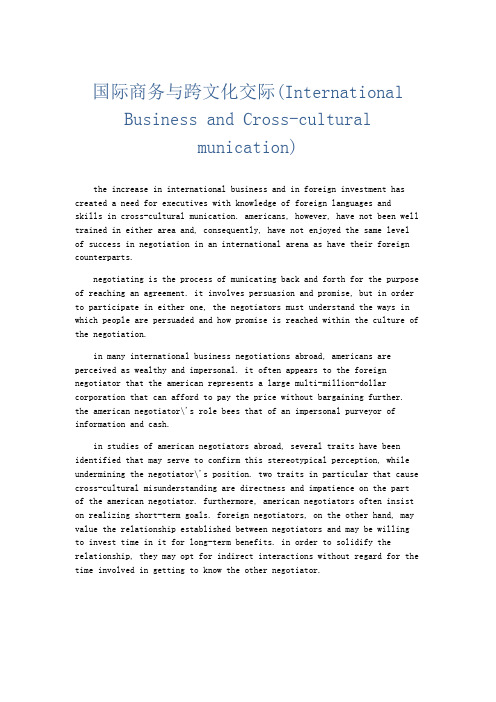
国际商务与跨文化交际(International Business and Cross-culturalmunication)the increase in international business and in foreign investment has created a need for executives with knowledge of foreign languages andskills in cross-cultural munication. americans, however, have not been well trained in either area and, consequently, have not enjoyed the same level of success in negotiation in an international arena as have their foreign counterparts.negotiating is the process of municating back and forth for the purpose of reaching an agreement. it involves persuasion and promise, but in order to participate in either one, the negotiators must understand the ways in which people are persuaded and how promise is reached within the culture of the negotiation.in many international business negotiations abroad, americans are perceived as wealthy and impersonal. it often appears to the foreign negotiator that the american represents a large multi-million-dollar corporation that can afford to pay the price without bargaining further. the american negotiator\'s role bees that of an impersonal purveyor of information and cash.in studies of american negotiators abroad, several traits have been identified that may serve to confirm this stereotypical perception, while undermining the negotiator\'s position. two traits in particular that cause cross-cultural misunderstanding are directness and impatience on the part of the american negotiator. furthermore, american negotiators often insist on realizing short-term goals. foreign negotiators, on the other hand, may value the relationship established between negotiators and may be willing to invest time in it for long-term benefits. in order to solidify the relationship, they may opt for indirect interactions without regard for the time involved in getting to know the other negotiator.2019年02月22日。
跨文化商务交际-unit 11Barriers to Intercultural Communication

【注】prejudice指预断,或在认知事件的相 关事实之前就以形成的观点。“偏见”指对一 个民族或个人先入为主的,通常是负面的 判断。由于性别、政见、社会地位、年龄、 缺陷、宗教、种族、语言、国籍、道德标 准、或是其它的个人特性等因素,“偏见”既 可以指正面的,又可以指负面的对他人的 评判,基于他人原有的集团成员的身份。 戈登·奥尔波特将偏见定义为“对人或对事, 先于,而不是基于实际体验的一种或有益 的,或不利的感觉。”
5. These communication stereotypes may be 'a key piece of the interracial relations puzzle.'
【 译文】 这些交际的固有模式可能就是“种 族间关系难题存在的关键因素。”
6. However, a cross-cultural study of prejudice in South Africa and the United States showed that racists in those countries did not necessarily have high levels of authoritarianism. 【译文】然而,对南非及美国的偏见进行的 跨文化研究表明这些国家的种族主义者并 不一定具有很高的权威性。
民族优越感
民族优越感之所以对跨文化人际沟通造成障碍,主 要是因为: 首先,对自己文化的民族优越感信念会 形成一种狭隘和防御性的社会认同感;其次,民族 优越感会以一种定型观念来感知其它文化;第三, 民族优越感会使沟通者将自己的文化与别的文化对 比时,总是吹捧自己的文化而贬低别的文化。民族 优越感会使人们不愿了解别的文化,拒绝承认别的 文化也具有丰富的内涵,排斥不同的观点和技术, 因而是跨文化沟通的障碍。
跨文化商务沟通整理
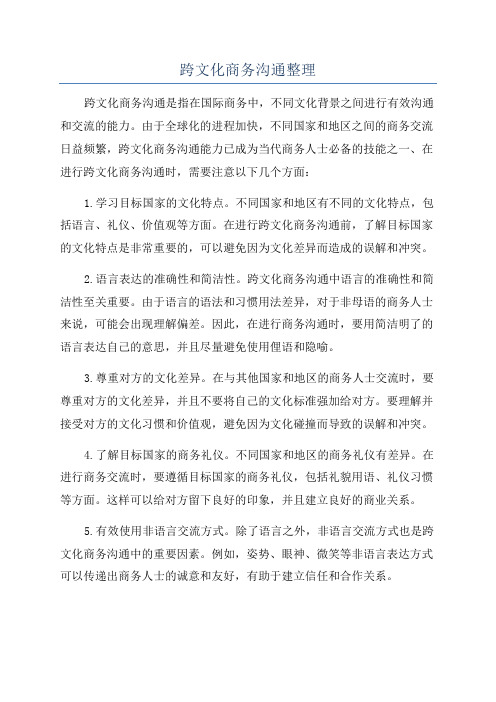
跨文化商务沟通整理跨文化商务沟通是指在国际商务中,不同文化背景之间进行有效沟通和交流的能力。
由于全球化的进程加快,不同国家和地区之间的商务交流日益频繁,跨文化商务沟通能力已成为当代商务人士必备的技能之一、在进行跨文化商务沟通时,需要注意以下几个方面:1.学习目标国家的文化特点。
不同国家和地区有不同的文化特点,包括语言、礼仪、价值观等方面。
在进行跨文化商务沟通前,了解目标国家的文化特点是非常重要的,可以避免因为文化差异而造成的误解和冲突。
2.语言表达的准确性和简洁性。
跨文化商务沟通中语言的准确性和简洁性至关重要。
由于语言的语法和习惯用法差异,对于非母语的商务人士来说,可能会出现理解偏差。
因此,在进行商务沟通时,要用简洁明了的语言表达自己的意思,并且尽量避免使用俚语和隐喻。
3.尊重对方的文化差异。
在与其他国家和地区的商务人士交流时,要尊重对方的文化差异,并且不要将自己的文化标准强加给对方。
要理解并接受对方的文化习惯和价值观,避免因为文化碰撞而导致的误解和冲突。
4.了解目标国家的商务礼仪。
不同国家和地区的商务礼仪有差异。
在进行商务交流时,要遵循目标国家的商务礼仪,包括礼貌用语、礼仪习惯等方面。
这样可以给对方留下良好的印象,并且建立良好的商业关系。
5.有效使用非语言交流方式。
除了语言之外,非语言交流方式也是跨文化商务沟通中的重要因素。
例如,姿势、眼神、微笑等非语言表达方式可以传递出商务人士的诚意和友好,有助于建立信任和合作关系。
6.善于倾听和沟通。
在进行跨文化商务沟通时,要善于倾听对方的意见和建议,并且积极参与到对话中去。
通过有效的沟通,可以更好地了解对方的需求和期望,进而实现双方的合作和共赢。
7.避免使用刻板印象和歧视性语言。
在跨文化商务沟通中,要避免使用刻板印象和歧视性语言。
不同国家和地区的文化是多样的,不能因为个别经历或者偏见而对整个国家或地区的人进行评判。
要用平等和尊重的态度对待对方,保持开放的心态,才能建立良好的商业关系。
跨文化商务交际 教材

跨文化商务交际教材跨文化商务交际是指在不同文化背景下,通过有效的沟通手段进行商业交流的过程。
这种交流可能是不同国家之间的商务活动,也可能是同一国家内不同文化背景的个人或组织之间的交流。
在全球化日益加速的今天,跨文化商务交际变得越来越重要。
由于不同文化背景下的价值观、商务习惯、法律法规等方面存在差异,如果不进行有效的跨文化商务交际,可能会导致误解、冲突甚至商业失败。
跨文化商务交际的核心是文化差异的管理。
这需要了解和尊重不同文化背景下的商务习惯、价值观和行为方式,通过有效的沟通手段来减少误解和冲突,实现商业目标。
在跨文化商务交际中,语言沟通和文化敏感性是非常重要的因素。
同时,还需要了解不同国家的法律法规、市场环境、消费者需求等方面的信息,以便更好地适应和开展商业活动。
此外,在跨文化商务交际中,还需要注意以下几个方面:建立信任关系:在跨文化交流中,建立信任关系非常重要。
这需要遵守商业道德和法律法规,同时通过诚实、透明的沟通建立互信关系。
了解文化差异:了解和尊重不同文化背景下的价值观、商务习惯和行为方式,可以帮助避免误解和冲突。
使用合适的语言:语言是跨文化商务交际中的重要工具。
使用合适的语言可以减少沟通障碍,提高沟通效率。
灵活应对:在跨文化商务交际中,可能会遇到各种不可预见的情况。
灵活应对可以帮助避免尴尬或冲突。
持续学习和适应:跨文化商务交际是一个持续学习和适应的过程。
通过不断学习和改进,可以提高跨文化商务交际的能力和效果。
教材是教学活动中所使用的资料,是教师传授知识的工具,是学生获取知识的源泉。
它包括教科书、讲义、参考书等。
教材是经过专家学者反复推敲、实践检验后才编写的,具有科学性、系统性和实践性等特点。
通过教材,学生可以系统地学习各种基础知识和基本技能,提高自己的综合素质和能力。
教材的编写和使用都应当遵循一定的原则。
首先,教材要符合国家的教育方针和教育规律,能够全面地提高学生的素质和能力。
其次,教材要注重实践性和实用性,能够帮助学生解决实际问题。
- 1、下载文档前请自行甄别文档内容的完整性,平台不提供额外的编辑、内容补充、找答案等附加服务。
- 2、"仅部分预览"的文档,不可在线预览部分如存在完整性等问题,可反馈申请退款(可完整预览的文档不适用该条件!)。
- 3、如文档侵犯您的权益,请联系客服反馈,我们会尽快为您处理(人工客服工作时间:9:00-18:30)。
Business Etiquette
❖ Gift-giving Customs
- Reminder of pleasant times and friendships
- Art, integral part of building intercultural professional and social relationships
Most IMP Female Guest
HOST
Dinner Table
HOSTESS
Most IMP Male Guest
Next Most IMP Male Guest
British Method
Business Etiquette
Chinese Method
Next Least IMP Guest
- Asia- A meaningful ritual, esp. Japan - Bilingual Cards preparation - Rank/ Title/ Profession/ Position/ Degree ❖ Avoid colored type and paper
Business Etiquette
- Gift-giving in America/China/JAPAN
Business Etiquette
❖ Gift-giving Customs
Business Etiquette
Gift-giving Customs
Business Etபைடு நூலகம்quette
❖ Business Dress
- Personality/education/background/Credibility /financial status
neurotic people (e.g. U.S.) - Extroverted culture (outgoing, dominating, social people) - Neurotic culture (Prone to guilt and general anxiety) - a tip of 15% of the bill (generous) - 20% of the bill - Non-tipping culture
HOST
Dinner Table
Most IMP Guest HOSTESS
Least IMP Guest
Next Most IMP Guest
Business Etiquette
❖ Tipping
- Nonverbal communication - Countries with more extroverted and
❖ Naming Systems - Which name to use - when to use a name
- e.g. U.S., Great Britain, Germany, China
Business Etiquette
❖ Business Card
- Europe- An expected part of al business introductions and most personal ones
- Business Card - Compliments and responses
- Terms of Address
- Refusals
- Greetings- Topic Choices
- Appointments - Dinning Etiquette
- Gift-giving Etiquette
- Visitors are better off exhibiting quiet good taste
- Exception: Watch - Dress for Men vs Dress for Women
Business Etiquette
❖ Key Factors By Marian Wiseman - Knowledge - Motivation - Skills (actions)
By Chen Guoming & William Starosta - Sensitivity - Awareness - Adroitness
Business Etiquette
HOST
Most IMP Female Guest
Next Most IMP Female Guest
Dinner Table
Next Most IMP Male Guest
Most IMP Male Guest
HOSTESS
Business Etiquette
Next Most IMP Female Guest
Protocol Elements
❖ 8 protocol elements
- names
- gift giving
- rank and title - food
- time
- drink
- communications - behavior
According to Carl A. Nelson
Business Etiquette
Business Etiquette
❖ Seating Arrangement - Most important guest in a honor relative to the host - French Method/ British Method
Business Etiquette
French Method
❖ Components - Michael Canale and Merrill Swain - 4 indispensable components * Linguistic * Sociolinguistic * Discourse * Strategic Competence
Intercultural Communication Competence
Intercultural Business Communication
Week 11
Contents
❖ Intercultural Communication (continued) ❖ Business Etiquette
- Initial Contact - Farewell
- Business Attire - Thanks and Responses
❖ Initial Contacts - Make an initial contact/appointment - Amount of advance notice between the contact and appointment
- e.g. Latin America, Egypt, Saudi Arabia, China
❖ Business Etiquette
Manners and behavior considered acceptable in social and business situations - How to do something gracefully
❖ Protocols
Customs and regulations dealing with diplomatic etiquette and courtesies expected in official dealings with persons in various cultures - What to do in a given situation
Cultural Shock
❖ Based on Oberg’s, 5 stages defined:
1. Exciting and New
2. Frustrated 3. Relax and Laugh
4. Rejection and Regression
5. Adjusted
Intercultural Communication Competence
Social Entertainment -- Dining Practices
1. Collective Approach stresses symbolism and ritual 2. Pluralist method is more pragmatic and egalitarian
• Time and place to dinning • Manner of eating • Number of the courses • What to order and eat
